Demystifying Nana’s Minced Pie
Demystifying Nana’s Minced Pie
We have entered the time of year of long evenings and with them, my daily routine has changed. Instead of heading out on a long walk after work, I bundle up for the brisk walk home in the dark. Upon arrival, I start a fire in the wood stove to heat the house before temperatures plummet even further. Contrary to many assumptions about the Sunshine State, it does get cold in California. Not Minnesota-cold, but this week it has been colder than in my home state of Massachusetts. Our low today was 7 degrees, and our high was 37, which incidentally was the low for Boston.
During these darker months, a typical evening finds me jockeying with the resident felines for couch space in front of the fire, our primary source of heat. Instead of outdoor exploration, winter evenings call for explorations of the mind and for armchair travel. Last week, I read about table etiquette from a cookbook written in 1941, the same year our house was built. [1] I learned about the existence of ice cream forks (who knew?), picked up tips from the chapter ‘Family Dinner Without a Maid’, and learned that when invited to Afternoon Tea, guests are expected to stay for just 15 to 30 minutes, “unless some entertainment is provided.” All that prep – especially for those of us without maids – for a 15-minute visit?
This week’s reading has centered on Irish Christmas traditions, which, I am learning, involve mince, or mincemeat, pies. My grandmother used to make these pastries, which I loved as a child, although their contents always remained something of a mystery. I never hear about mince pies these days. Curious to see if I had a recipe on-hand, I reached for Vegan Pie. No mention of mincemeat. How to Cook Everything? Apparently ‘mincemeat’ isn’t part of ‘everything’. Well, perhaps it is more of a British Isles dish. I peruse a British vegan cookbook and three cookbooks by Irish vegetarian chef Denis Cotter. Still no luck.
Then my eyes rest upon a couple of reprints of early 19th-century American books that I picked up on a visit to the Culinary Arts Museum in Providence last year. A Cook’s Own Book, written in 1832 by ‘A Boston Housekeeper’, is an encyclopedic reference that includes an entry for Mince Meat. My delight at having found a recipe is tempered somewhat by the observation that “The lean side of a buttock, thoroughly roasted, is generally chosen for mince meat.” A Poetical Cook-Book (Philadelphia,1864) has a recipe for Mince Pies, with an ingredient list that starts out with ‘Two pounds of boiled beef’s heart or fresh tongue, or lean fresh beef, chopped, when cold; two pounds of beef suet chopped fine.” The 1941 etiquette book’s recipe for Mincemeat calls for a pound of lean beef and ¼ pound suet (raw beef or mutton fat). Another recipe calls for meat liquor, whatever that is.
Are we still talking about Nana’s pies? I was envisioning something sweet, of raisins and apples. And I’m not thrilled at the prospect of figuring out how to veganize fresh tongue or beef suet or stork margarine.
Back to the bookshelf, where I find that The Science of Food and Cookery, a vegetarian cookbook from 1921, has a meatless version made with green tomato mince. I would not have expected that green tomato could sub for rump roast, yet I see this repeated in The Good Housekeeping Cook Book (1942), which has two recipes: Mincemeat I (Made of Meat) and Mincemeat II (Made of Green Tomatoes). The Greater American Cook Book (1939) divides American cuisine into eleven regions and includes its mince recipes in the New England section.
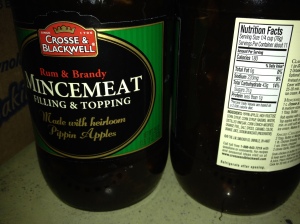
Mincemeat filling is sometimes available in stores, in case your diet is lacking in high fructose corn syrup and regular corn syrup. It is curious that this product is called ‘Rum and Brandy’ when neither of those ingredients is present.
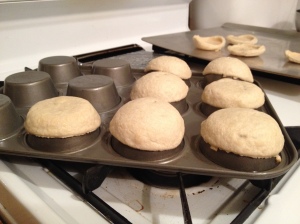
DIY mini pie shells can be made in a pinch with an inverted cupcake tin. Don’t forget to grease the tin before folding the dough over each cup.
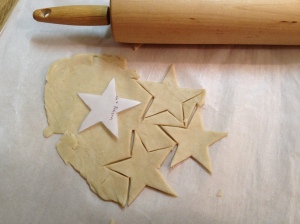
Stars are a traditional minced pie topper, representing the Christmas Star that led the shepherds and Magi to Bethlehem.
Based on my cursory exploration thus far, mincemeat seems to have been a very old recipe that was at one time popular in the northeastern U.S., disappearing sometime in the 1940s. It commonly contained some kind of beef or, alternately, green tomatoes. Beef or tomatoes aside, the rest of the ingredients for the recipes are identical: a mix of apples, dried fruit, alcohol (brandy or rum), and great proportions of potent herbs: nutmeg, cinnamon, and cloves.
I turn to internet research, which confirms that mince pie is a standard holiday dessert in England, Scotland, and Ireland. Also known as Christmas Pie, it is believed to date back to the 1500s (or earlier, depending on the source), when European crusaders returned from the Middle East with new spices and recipes that combined meat, fruit, and spices. Mincemeat may have developed as a way to preserve meat without salting or smoking. The sugars and alcohol enable the meat to keep for several months (yes, months) during cold weather.
Several sources claim that the pie’s three spices (cinnamon, cloves, and nutmeg) represent the Three Magi and that traditional recipes call for thirteen ingredients, representing Jesus and his apostles. Due to the pie’s associations with Catholicism, it was banned during the English Civil War (1600s) as heretical, and described later as “the Scarlet Whore of Babylon, an Hodge-Podge of Superstition, Popery, the Devil and all his Works.”[2] Quite a controversial little pie!
Historically, minced (or mincemeat) pie contained more meat than fruit and was eaten as a main course rather than as dessert. Over the years, as more fruit and spices became available, the filling came to be almost entirely comprised of dried fruit (raisins, currants, cherries, apricots, candied lemon and orange peel), spices, nuts, and alcohol. The only vestige of the pie’s meaty past is suet, which is still occasionally used in modern recipes. Other contemporary recipes call for a vegetarian suet or omit it altogether.
For a well-documented compilation of historical mincemeat recipes, see here. And for an absolute jewel of an essay, see The Real American Pie, an informative and entertaining investigation by the late Cliff Doerksen into what was once America’s defining national dish.
Recipe
Mincemeat filling
I used the Bon Appétit recipe for Mock Mincemeat Pie as a base. The only changes I made were to omit the butter (which didn’t have any apparent role in the flavor or texture of the pie), change the type (but not the quantity) of dried fruit, and add nutmeg, so that the pie would have its three traditional spices. The dried fruits I used were raisins (instead of currants), apricots (instead of golden raisins), and cherries (instead of cranberries). You can make the filling ahead of time and let it sit for days (or even months) to absorb the flavor more fully.
Pie Crust
You can make your own or buy commercial, most of which is vegan. Since I was short on time, I bought a new commercial organic brand that recently showed up in our supermarket. I did not have mini pie tins, so I made mini crusts by rolling out the pie dough and cutting out 3”-diameter circles (I think 4” would be a better size, if you have it). I then shaped pie shells on an inverted cupcake tin (greased with canola oil) and baked at 350 degrees for 6 minutes until they could hold their shape. I removed the mini pie shells, filled them with mincemeat, placed a star atop each one (a traditional touch, and more Christmas imagery, no doubt), and returned them to the oven to bake for an additional 20-25 minutes.
Result: a flaky and delicious tartlet reminiscent of Nana’s. Merry Christmas!
December 5, 2013
[1] Practical Cookery and Etiquette and Service of the Table: Manhattan, KS: Kansas State College of Agriculture and Applied Science, 1941.
[2] Brand, John. Observations on the Popular Antiquities of Great Britain: Chiefly Illustrating the Origin of Our Vulgar and Provincial Customs, Ceremonies, and Superstitions, Volume 1. 1873.

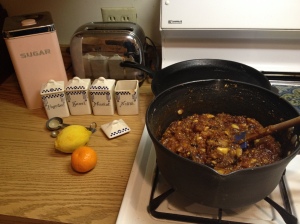
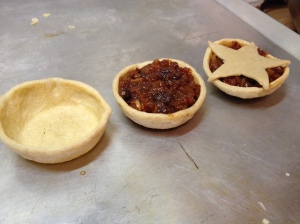
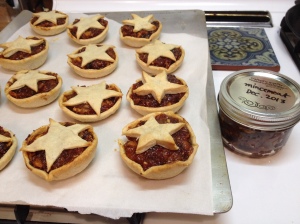




Nice job! I grew up eating what we called Mince Pie every T-Day and Xmas at my Aunt’s house in Pomona, CA. It was pre-made and didn’t use suet, but our fondness for it signaled the residual British-ness of my Grandmother’s family. It was my favorite.
Thanks for this lovely synopsis that encompasses both family and culinary history! I loved mincemeat as a kid too, and was very annoyed to discover that it actually contained meat. Great to learn about some alternatives.